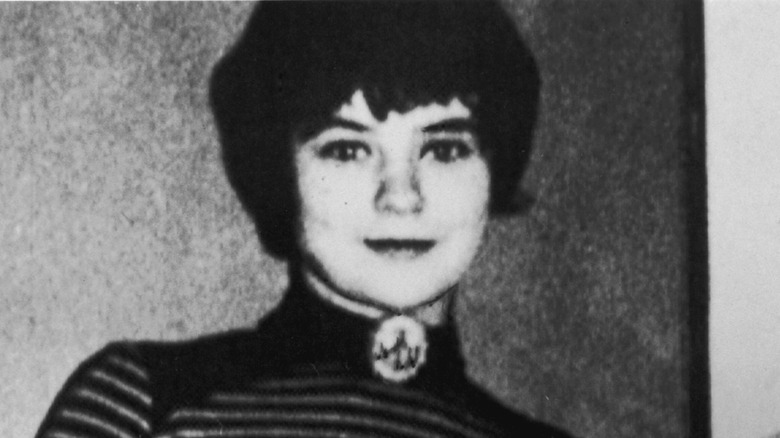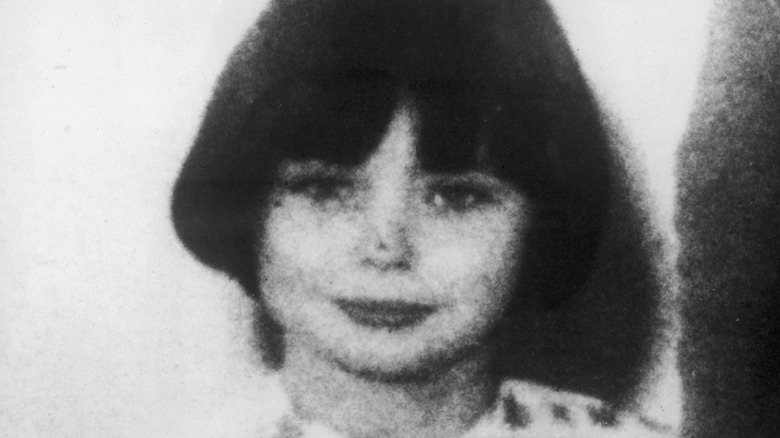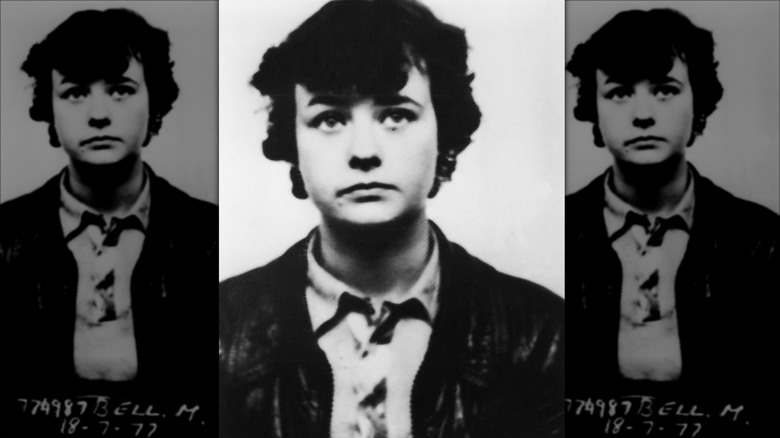Inside The Story Of Mary Bell, The 11-Year-Old Serial Killer
This article contains mentions of violence and child sex abuse.
Statistically speaking, it's incredibly rare for children to commit homicide. As Psychology Today noted in a 2017 article on the subject, kids under the age of 14 in the U.S. make up less than 1% of perpetrators convicted of murder overall, and on average, only 74 children per year become killers. Out of that pool, a whopping 90% are identified as male, and as a 2017 study published by the National Library of Medicine noted, the majority of homicides perpetrated by children were committed by boys who used guns. While the study also noted that the U.S. had a comparatively higher rate of child murderers than other countries, it doesn't mean that they don't happen anywhere else. It also brings up an age-old question: What exactly makes a murderer?
According to some criminologists — like Dr. Adrian Raine, who published a book on the subject titled "The Anatomy of Violence" in 2013 — what compels a child, or anyone, to commit murder can't be chalked up to any one thing. According to Raine, "genetics and environment work together to encourage violent behavior" — meaning rather than nature or nurture, it's a mix of both (via Psychiatry Advisor). Nevertheless, it's especially shocking when a child is a culprit, and that was exactly the case when two crimes shocked the unassuming suburbs of Newcastle, England, in 1968. Even more shocking was the person who became the prime suspect: a local 11-year-old girl named Mary Bell.
Mary Bell's horrific childhood
In the summer of 1968, two boys, 4-year-old Martin Brown and 3-year-old Brian Howe, respectively died within weeks of each other. As chronicled in the 1999 book "Cries Unheard: The Story of Mary Bell" (via The New York Times), Brown's death had been initially ruled an accident — but in the case of Howe, the child had clearly been murdered. This triggered authorities to wonder if Brown's death hadn't been a mishap. Even more shocking was that the coroner stated whoever had murdered them was a child themselves. Everything came to a head when authorities zeroed in on then-11-year-old Mary Bell (pictured above), who had acted suspiciously following each crime, showing immense interest in both cases.
Born in 1957, Bell entered a world of neglect and violence, according to "Cries Unheard." Her mother, Betty McCrickett, was a teenage sex worker who, by her account, never knew her father. When she was just 5 years old, Bell reportedly witnessed a friend's death when they were run over by a bus. By all accounts, Bell was severely abused by her mother during her childhood. Some believe that McCrickett exploited her young daughter and forced her into sex work, and may have tried to kill her under the guise of suspicious accidents.
Bell did survive — but she also began to show disturbing signs of what was to come. Per "Cries Unheard," she was bright but violent and manipulative and showed little emotion or empathy. Bell also attacked other children at school, and even tried to strangle a young girl.
The heinous murders
On May 25, 1968, Mary Bell, along with her friend Norma Bell (no relation), coaxed 4-year-old Martin Brown into an abandoned building (via Owlcation) located in the suburbs of the city of Newcastle. Once inside, she strangled the child and fled. Per the book "Cries Unheard: The Story of Mary Bell" (via Crime + Investigation U.K.), Brown's lifeless body was later found by two boys — followed by Mary and Norma, who had returned to the scene of the crime. Both girls were there when the police arrived, but there was nothing to indicate that Brown had been murdered, so the case was closed, per Owlcation. According to "Cries Unheard," Mary Bell reportedly later showed up at Brown's residence and asked to see the boy. When his mother explained he was dead, Bell asserted that she knew, but that she wanted to "see him in his coffin."
Days after Brown's murder, Mary and Norma broke into a local school and left anonymous notes stating they had killed Brown, per "Cries Unheard." Although police dismissed it as an unsettling joke, a security system was subsequently installed. It wasn't long before both girls were found outside of the school after setting off the alarm. Claiming innocence, they were only given a warning and otherwise let off. But it wasn't long before they would strike again.
The small detail that implicated Mary Bell in the murders
This time, Mary Bell and her accomplice, Norma Bell, lured a 3-year-old boy named Brian Howe to what author Gitta Sereny in her book "Cries Unheard: The Story of Mary Bell" described as a "wasteland" located in the Newcastle suburb where all three children resided (via Crime + Investigation U.K.). Afterward, Mary strangled him and used a pair of scissors to, among other things, carve the letter "M" into his stomach — a clue which would later be useful to investigators.
According to "Cries Unheard," Howe's sister went to search for her younger brother after realizing he had been gone for some time. Ominously, both Mary and Norma helped aid in the search, and eventually, the body was found. At that point — and now with the murders of two children on their hands — police kicked into high gear. According to Owlcation, the police decided to speak to the local children after the coroner let authorities know a child was likely the killer. One boy told officers that he had seen Mary with Howe, which proved to be the last sighting of the toddler alive.
After receiving tips about Mary and Norma's suspicious behavior following Martin Brown's death, they interviewed both girls. Their stories didn't add up. Mary's fabricated account, however, included a key giveaway: She stated that she had seen Howe with another boy carrying a pair of scissors. As the police had not released the details regarding the use of scissors in the crime, it became evident they had their killer.
Mary Bell's trial received widespread coverage
According to "Cries Unheard: The Story of Mary Bell" (via Crime + Investigation U.K.), the evidence against Mary Bell quickly piled up. Experts concluded that she and Norma Bell had written the notes confessing their involvement with Brown's murder left at their school. There was also the witness that had seen Mary Bell with Howe. Additionally, fibers from the girl's clothing matched fibers that were found on both victims. Finally, there was Mary's documented history of violent behavior. At the girls' trial, the prosecution stated that they had committed these crimes "solely for the pleasure and excitement of killing," per "Cries Unheard" (via Serial Killers True Crime Anthology 2014).
While Norma Bell showed emotion during the trial, Mary Bell remained stoic, per "Cries Unheard." Mary was also painted as the mastermind behind the murders, while Norma was described as "simple-minded." Diagnosed as a psychopath by psychiatrists during the trial, experts concluded that her psychopathy meant that she lacked the awareness and responsibility in committing the crimes, per Owlcation. Ultimately, Mary was found guilty of manslaughter instead of murder and was handed an unspecified life sentence in December 1968. Norma, who purportedly displayed signs of remorse, had the charges against her dismissed.
Mary Bell is still alive and living under the veil of anonymity
As The New York Times noted in their coverage of the 1998 release of "Cries Unheard" by author Gitta Sereny, Mary Bell served 12 years in prison for the murders of Brian Howe and Martin Brown, shuffling from institution to institution, with an intermittent escape from one of them in 1977. Upon her release in 1980 at the age of 23, Bell was given a new name and identity by the British government, and gave birth to a daughter in 1984, per Owlcation.
Since tasting freedom over four decades ago, Bell was (and as of this writing, is) continually sought out by the public and press, who from time to time managed to locate her despite her guise of anonymity. Bell did, however, speak directly to Sereny for "Cries Unheard," which was received with controversy, as The New York Times pointed out in their own review of the work — and even more so when it was discovered Bell had been paid to recount her story to the book's author, as the Daily Mail noted years later.
In 2009, the mother of Martin Brown, June Richardson, spoke with the Daily Mail about Bell's consideration by the British legal system, expressing frustration and anger over the matter. "It's all about her and how she has to be protected," stated Richardson, who added that the family of those murdered by Bell are, by extension, also victims — ones who had not been " given the same rights as killers [like Mary Bell]."
If you or anyone you know has been a victim of sexual assault, help is available. Visit the Rape, Abuse & Incest National Network website or contact RAINN's National Helpline at 1-800-656-HOPE (4673).





